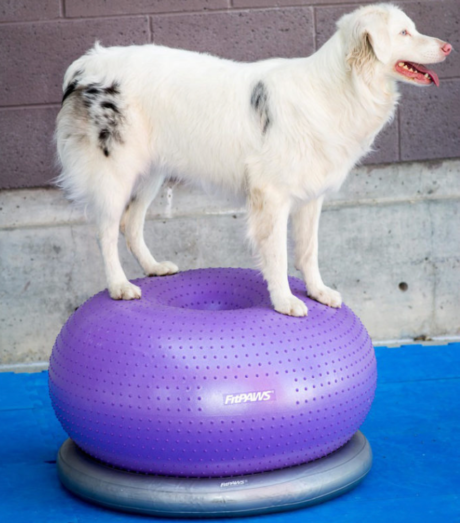
Gyms have all sorts of balance and stability equipment these days. They may include traditional exercise balls, foam pads of all sizes, Bosu balls, and inflatable discs.
Why is that? Well, balance and stability are to so important to many aspects of health for dogs and humans. It can help dogs of any age, from puppy development skills to the senior dog that has lost strength and stability from age related weakness.
In human physical therapy, as with canine rehabilitation, we are focused on functional strength and functional mobility. We first define what we are asking our dogs to do on a daily basis:
- Are they hanging around the house all day – sleeping/resting?
- Are they active? Sporting or hunting dog?
- Do they have carpet or wood/ tile floors?
- Or do they need mobility assistance to go outside for a bathroom break?
- Are they performance dogs? Agility dogs or perhaps dock diving?
The goals of balance and stability activities are to enhance the proprioceptive feedback (body awareness), encourage weight shifts and muscle contractions, facilitate balance and function.
Remember, if you have any concerns about whether or not your dog is healthy enough to try these activities, seek the advice of your Veterinarian first.
The Right Support:
Safety is paramount. The bigger the piece of equipment the more support you will need to provide. I advise my clients to use a chest type harness to support the dog from the chest. In my video I am using a very basic harness because I want everyone to see the dog’s muscle tone and movement, plus she is really good with these activities and she doesn’t require as much physical support.
The idea is not to support or lift the dog’s weight instead it is to provide control, the support is distributed through the chest, and less likely the dog will fall. It is also necessary to consider your comfort and body mechanics. Ensure you are comfortable and using good posture. Consider supporting the equipment either with your legs or hands, or up against a wall. Watch the video to see some examples.
The Right Platform:
There are several types of platforms available. I use a few in the video. To ensure you are providing the best experience for your dog I recommend filling the FitPAWS TRAX donut or peanut until it is firm to the touch. For the K9FITbone I like it a bit more deflated, so it is not high centered when you lay it flat. It is my opinion that the firmer the piece is to the touch, the easier it is to get your dog started. With more inflation there is less rolling resistance that makes them harder to support if not being assisted with your legs or a wall.
Once the item is supported your dog will be standing on a firmer surface making it easier on them. Last but not least, never leave the equipment unattended. Do not allow your dog to jump on them without personal support. If your dog is on the equipment you must be giving it support.
Muscle Targeting:
Balance work enables you to target postural muscles and reflexes. These are slower twitch, high endurance muscles and muscles that help hold you up against gravity. It works the whole body with contraction and co-contraction of many muscle groups, from the shoulders and forelimbs, all the way down the spine and core, to the hips and hind legs.
Instead of repetitions, in balance work think about duration, or how long can they can sustain it. Start with a few minutes at a time and observe your dogs tolerance.
Starting Out:
Begin with standing and holding activities, then progress to functional movements like sit to stands, and turns with slow purposeful movements. These activities can be done every day for a few minutes at a time. Mix it up. Try doing some balance work before or after a walk. Vary the activities and types of balance pieces to make it fun and different each time.
Each dog is different and you must be able to tell when your dog is close to fatigue. Some signs may be panting with tongue out, muscles twitching, leaning into you, trying to sit or lay down on it.
As you will see on the blog video, I use 3 different pieces of balance and stability equipment. I don’t like to say that one is easier or harder than another because there are so many ways to use each one.
I like to recommend starting with the K9FITbone, then the FitPAWS TRAX Donut, and finally the FitPAWS Peanut. Introducing a variety of platforms and progressing from low level to a higher level platform helps you start without begin too far off the ground.
The FitPAWS Donut I like to brace between my legs (sitting on a carpeted floor or a chair). I continue to ask the dog to stand, turn, on and off with great success. I like to use treats to encourage motivation. Use what you fell necessary to encourage participation.
Instability Challenges:
There are three basic ways to create a challenge for your dog on any platform:
1) Ask your dog to stand on the item and physically manipulate your dog with small motions.
2) Manually manipulate the surface under your dog to make it more difficult.
3) Reduce the amount of support you provide (reduce air, less harness support) to make them more unstable.
Author: Anthony Woerner, PTA, CCRP
Link: https://fitpawsusa.com/guest-writer/balance-stability-exercises/




